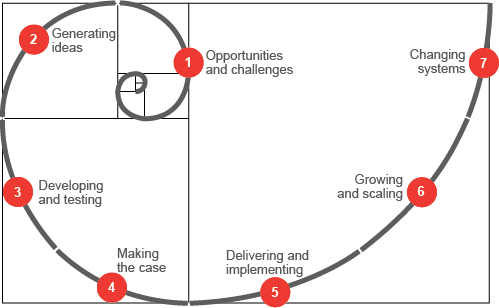5.1 What is the correct order for teaching the DIY Learn modules?
The DIY tools can all be studied and used independently, but will probably have most value (particularly for a group) when seen in the context of a process of innovation. The following section of the Handbook is taken from http://diytoolkit.org/ background, where you will find further detail and references if needed.
Innovation is sometimes written about as something almost magical. However it is wrong to see innovation as a mystery. It is true that innovation is rarely simple or predictable but, looking closely at what actually happens, it is also true that the overall innovation process is structured and systematic.
Although every real innovation is a complex story of loops and jumps, there are various stages that most innovations pass through. This framework is useful for understanding how to put ideas to work, and focusing on the different methods, and different mindset, needed at each stage.

The seven stages are:
1. Opportunities and challenges: These include all the initiating factors like a crisis, new evidence, inspirations etc. that highlight the need for change. This might involve diagnosing the root causes of a problem, or identifying the opportunities that a new change could bring about.
2. Generating ideas: Most of the ideas you come up with at first won’t work. But it’s only through the process of constant idea creation that you arrive at something that is radical and transformative. Use creative methods like design to increase the number of solution options from a wide range of sources.
3. Developing and testing: New ideas are always helped by robust criticism. It is through trial and error that ideas are iterated and strengthened. This can be done by simply trying things out, or through more rigorous prototyping and randomised controlled trials.
4. Making the case: Before you try to implement your idea, you need to prove that it can work and is better than what is already there. Build up firm evidence to back it up and then share it honestly.
5. Delivering and implementing: This is when the solution becomes everyday practice. It includes identifying what is working well, and what is not, as well as securing income streams that enable the long-term financial sustainability to carry the innovation forward.
6. Growing and scaling: In this stage there are a range of strategies for growing and spreading an innovation – from organisational growth to licensing and franchising. Emulation and inspiration also play a critical role in spreading an idea or practice in a more organic and adaptive manner.
7. Changing systems: Systemic innovation is where maximum social impact can be created. It usually involves changes in the public and private sector over long periods of time, and the interaction of many elements and new ways of thinking.
The tools in the DIY toolkit are grouped to help you understand how they fit into this process of innovationFootnote 1. According to your needs, you could pick one or two tools from each stage to explore in order, or focus in on all the tools for one stage that might be proving especially challenging for your group.
5 Using DIY Learn modules for classroom teaching
